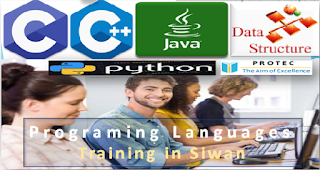What is the Python Programming language?
Python is the most widely used programming language used all over the world. It was developed by Guido Van Rossum in 1991. Python can be used for small as well as big online or offline projects. It has a design concept that the language features the readability of the code, prominently using significant whitespace i.e. the code is readable comparatively to the other programming languages, and it is supported by a large number of frameworks.
Python interpreters are available for many operating systems. Python, the reference implementation of Python, is open source software and has a community-based development model.
Features Of Python:
- Interpreted Language: Python is an interpreted language. It executes the code line by line at a time. Python converts the source code into bytecodes. Then translates this into the native language of your specific computer. You just run your programs and you never have to worry about linking and loading with libraries, etc.
- Cross-platform language: Python can run on different platforms such as Windows, Linux, UNIX, Macintosh etc. A Python program can write on a Macintosh computer will run on a Linux system and vice versa.
- Free and Open Source: Python is free and open source software. It is freely available you can easily download it. Its source code is available to the public. You can easily download it, change it, use it, and distribute it.
- Object-Oriented language: Python is an object-oriented programming language. Python’s class mechanism adds classes with a minimum of new syntax and semantics. It is a mixture of the class mechanisms found in C++ and Modula-3. Python classes provide all the standard features of Object Oriented Programming Language.
- Extensive Libraries: Python library contains built-in modules that provide access to system functionality. It can help you do various things involving regular expressions, documentation generation, unit testing, threading, databases etc.
- Integrated: Python can be easily integrated with languages like C, C++, and Java etc.
- Databases Connectivity: Python provides an interface to all commercial databases.
- Python is dynamically typed: it means that you don't declare a type (e.g. 'integer') for a variable name, and then assign something of that type (and only that type). Instead, you have variable names, and you bind them to entities whose type stays with the entity itself. a = 5 makes the variable name a to refer to the integer 5. Later, a = "hello" makes the variable name a to refer to a string containing "hello". Static typed languages would have you declare int a and then a = 5, but assigning a = "hello" would have been a compile time error. On one hand, this makes everything more unpredictable (you don't know what a refers to). On the other hand, it makes very easy to achieve some results a static typed languages makes very difficult.
If you want to learn WordPress let's join our classes at Protec Computer Academy in Siwan.















 Computer quiz for competitive exams | Bank, PO, SCC and many more...
Computer quiz for competitive exams | Bank, PO, SCC and many more...
0 Comments:
Post a Comment
Please don't enter any spam link in the comment box.